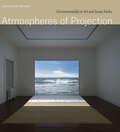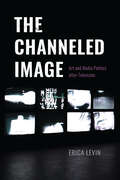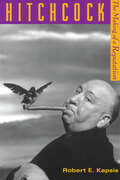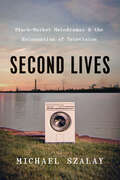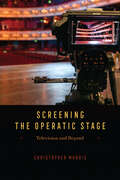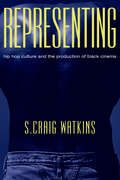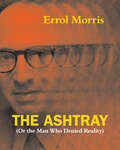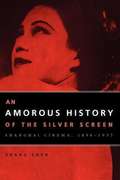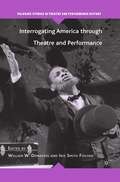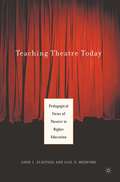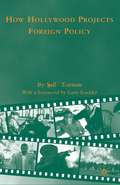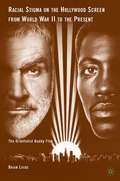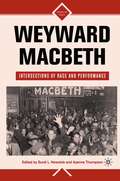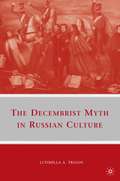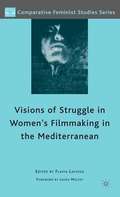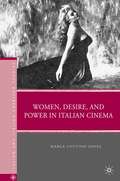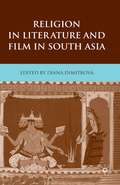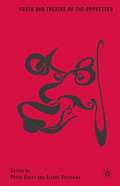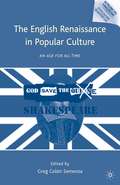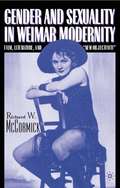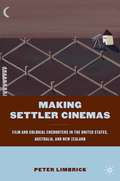- Table View
- List View
Atmospheres of Projection: Environmentality in Art and Screen Media
by Giuliana BrunoBringing together cultural history, visual studies, and media archaeology, Bruno considers the interrelations of projection, atmosphere, and environment. Projection has long been transforming space, from shadow plays to camera obscuras and magic lantern shows. Our fascination with projection is alive on the walls of museums and galleries and woven into our daily lives. Giuliana Bruno explores the histories of projection and atmosphere in visual culture and their continued importance to contemporary artists who are reinventing the projective imagination with atmospheric thinking and the use of elemental media. To explain our fascination with projection and atmosphere, Bruno traverses psychoanalysis, environmental philosophy, architecture, the history of science, visual art, and moving image culture to see how projective mechanisms and their environments have developed over time. She reveals how atmosphere is formed and mediated, how it can change, and what projection can do to modify a site. In so doing, she gives new life to the alchemic possibilities of transformative projective atmospheres. Showing how their “environmentality” produces sites of exchange and relationality, this book binds art to the ecology of atmosphere.
Atmospheres of Projection: Environmentality in Art and Screen Media
by Giuliana BrunoBringing together cultural history, visual studies, and media archaeology, Bruno considers the interrelations of projection, atmosphere, and environment. Projection has long been transforming space, from shadow plays to camera obscuras and magic lantern shows. Our fascination with projection is alive on the walls of museums and galleries and woven into our daily lives. Giuliana Bruno explores the histories of projection and atmosphere in visual culture and their continued importance to contemporary artists who are reinventing the projective imagination with atmospheric thinking and the use of elemental media. To explain our fascination with projection and atmosphere, Bruno traverses psychoanalysis, environmental philosophy, architecture, the history of science, visual art, and moving image culture to see how projective mechanisms and their environments have developed over time. She reveals how atmosphere is formed and mediated, how it can change, and what projection can do to modify a site. In so doing, she gives new life to the alchemic possibilities of transformative projective atmospheres. Showing how their “environmentality” produces sites of exchange and relationality, this book binds art to the ecology of atmosphere.
The Channeled Image: Art and Media Politics after Television
by Erica LevinA fascinating look at artistic experiments with televisual forms. Following the integration of television into the fabric of American life in the 1950s, experimental artists of the 1960s began to appropriate this novel medium toward new aesthetic and political ends. As Erica Levin details in The Channeled Image, groundbreaking artists like Carolee Schneemann, Bruce Conner, Stan VanDerBeek, and Aldo Tambellini developed a new formal language that foregrounded television’s mediation of a social order defined by the interests of the state, capital, and cultural elites. The resulting works introduced immersive projection environments, live screening events, videographic distortion, and televised happenings, among other forms. For Levin, “the channeled image” names a constellation of practices that mimic, simulate, or disrupt the appearance of televised images. This formal experimentation influenced new modes of installation, which took shape as multi-channel displays and mobile or split-screen projections, or in some cases, experimental work produced for broadcast. Above all, this book asks how artistic experimentation with televisual forms was shaped by events that challenged television broadcasters’ claims to authority, events that set the stage for struggles over how access to the airwaves would be negotiated in the future.
The Channeled Image: Art and Media Politics after Television
by Erica LevinA fascinating look at artistic experiments with televisual forms. Following the integration of television into the fabric of American life in the 1950s, experimental artists of the 1960s began to appropriate this novel medium toward new aesthetic and political ends. As Erica Levin details in The Channeled Image, groundbreaking artists like Carolee Schneemann, Bruce Conner, Stan VanDerBeek, and Aldo Tambellini developed a new formal language that foregrounded television’s mediation of a social order defined by the interests of the state, capital, and cultural elites. The resulting works introduced immersive projection environments, live screening events, videographic distortion, and televised happenings, among other forms. For Levin, “the channeled image” names a constellation of practices that mimic, simulate, or disrupt the appearance of televised images. This formal experimentation influenced new modes of installation, which took shape as multi-channel displays and mobile or split-screen projections, or in some cases, experimental work produced for broadcast. Above all, this book asks how artistic experimentation with televisual forms was shaped by events that challenged television broadcasters’ claims to authority, events that set the stage for struggles over how access to the airwaves would be negotiated in the future.
Hitchcock: The Making of a Reputation
by Robert E. KapsisFrom the beginning of his career, Alfred Hitchcock wanted to be considered an artist. Although his thrillers were immensely popular, and Hitchcock himself courted reviewers, he was, for many years, regarded as no more than a master craftsman. By the 1960s, though, critics began calling him an artist of unique vision and gifts. What happened to make Hitchcock's reputation as a true innovator and singular talent? Through a close examination of Hitchcock's personal papers, scripts, production notes, publicity files, correspondence, and hundreds of British and American reviews, Robert Kapsis here traces Hitchcock's changing critical fortunes. Vertigo, for instance, was considered a flawed film when first released; today it is viewed by many as the signal achievement of a great director. According to Kapsis, this dramatic change occurred because the making of the Hitchcock legend was not solely dependent on the quality of his films. Rather, his elevation to artist was caused by a successful blending of self-promotion, sponsorship by prominent members of the film community, and, most important, changes in critical theory which for the first time allowed for the idea of director as auteur. Kapsis also examines the careers of several other filmmakers who, like Hitchcock, have managed to cross the line that separates craftsman from artist, and shows how Hitchcock's legacy and reputation shed light on the way contemporary reputations are made. In a chapter about Brian De Palma, the most reknowned thriller director since Hitchcock, Kapsis explores how Hitchcock's legacy has affected contemporary work in—and criticism of—the thriller genre. Filled with fascinating anecdotes and intriguing excerpts, and augmented by interviews with Hitchcock's associates, this thoroughly documented and engagingly written book will appeal to scholars and film enthusiasts alike. "Required reading for Hitchcock scholars...scrupulously researched, invaluable material for those who continue to ask: what made the master tick?"—Anthony Perkins
Second Lives: Black-Market Melodramas and the Reinvention of Television
by Michael SzalayA history of prestige television through the rise of the “black-market melodrama.” In Second Lives, Michael Szalay defines a new television genre that has driven the breathtaking ascent of TV as a cultural force over the last two decades: the black-market melodrama. Exemplified by the likes of The Sopranos and Breaking Bad, the genre moves between a family’s everyday life and its secret second life, which may involve illegal business, espionage, or even an alternate reality. Second lives allow characters (and audiences) to escape what feels like endless work into a revanchist vision of the white middle class family. But there is for this grimly resigned genre no meaningful way back to the Fordist family wage for which it longs. In fact, Szalay argues, black-market melodramas lament the very economic transformations that untethered TV viewing from the daily rhythms of the nine-to-five job and led, ultimately, to prestige TV.
Second Lives: Black-Market Melodramas and the Reinvention of Television
by Michael SzalayA history of prestige television through the rise of the “black-market melodrama.” In Second Lives, Michael Szalay defines a new television genre that has driven the breathtaking ascent of TV as a cultural force over the last two decades: the black-market melodrama. Exemplified by the likes of The Sopranos and Breaking Bad, the genre moves between a family’s everyday life and its secret second life, which may involve illegal business, espionage, or even an alternate reality. Second lives allow characters (and audiences) to escape what feels like endless work into a revanchist vision of the white middle class family. But there is for this grimly resigned genre no meaningful way back to the Fordist family wage for which it longs. In fact, Szalay argues, black-market melodramas lament the very economic transformations that untethered TV viewing from the daily rhythms of the nine-to-five job and led, ultimately, to prestige TV.
Screening the Operatic Stage: Television and Beyond (Opera Lab: Explorations in History, Technology, and Performance)
by Christopher MorrisAn ambitious study of the ways opera has sought to ensure its popularity by keeping pace with changes in media technology. From the early days of television broadcasts to today’s live streams, opera houses have embraced technology as a way to reach new audiences. But how do these new forms of remediated opera extend, amplify, or undermine production values, and what does the audience gain or lose in the process? In Screening the Operatic Stage, Christopher Morris critically examines the cultural implications of opera’s engagement with screen media. Foregrounding the potential for a playful exchange and self-awareness between stage and screen, Morris uses the conceptual tools of media theory to understand the historical and contemporary screen cultures that have transmitted the opera house into living rooms, onto desktops and portable devices, and across networks of movie theaters. If these screen cultures reveal how inherently “technological” opera is as a medium, they also highlight a deep suspicion among opera producers and audiences toward the intervention of media technology. Ultimately, Screening the Operatic Stage shows how the conventions of televisual representation employed in opera have masked the mediating effects of technology in the name of fidelity to live performance.
Screening the Operatic Stage: Television and Beyond (Opera Lab: Explorations in History, Technology, and Performance)
by Christopher MorrisAn ambitious study of the ways opera has sought to ensure its popularity by keeping pace with changes in media technology. From the early days of television broadcasts to today’s live streams, opera houses have embraced technology as a way to reach new audiences. But how do these new forms of remediated opera extend, amplify, or undermine production values, and what does the audience gain or lose in the process? In Screening the Operatic Stage, Christopher Morris critically examines the cultural implications of opera’s engagement with screen media. Foregrounding the potential for a playful exchange and self-awareness between stage and screen, Morris uses the conceptual tools of media theory to understand the historical and contemporary screen cultures that have transmitted the opera house into living rooms, onto desktops and portable devices, and across networks of movie theaters. If these screen cultures reveal how inherently “technological” opera is as a medium, they also highlight a deep suspicion among opera producers and audiences toward the intervention of media technology. Ultimately, Screening the Operatic Stage shows how the conventions of televisual representation employed in opera have masked the mediating effects of technology in the name of fidelity to live performance.
Representing: Hip Hop Culture and the Production of Black Cinema
by S. Craig WatkinsIn this engaging and provocative book, S. Craig Watkins examines two of the most important developments in the recent history of black cinema—the ascendancy of Spike Lee and the proliferation of "ghettocentric films." Representing explores a distinct contradiction in American society: at the same time that black youth have become the targets of a fierce racial backlash, their popular expressive cultures have become highly visible and commercially viable. "Watkins is at his most sophisticated and persuasive when he explains the surprising success of hyper-talented, entrepreneurial, and energetic black artists."—Archon Fung, Boston Book Review
The Ashtray: (Or the Man Who Denied Reality)
by Errol MorrisIn 1972, philosopher of science Thomas Kuhn threw an ashtray at Errol Morris. This book is the result. At the time, Morris was a graduate student. Now we know him as one of the most celebrated and restlessly probing filmmakers of our time, the creator of such classics of documentary investigation as The Thin Blue Line and The Fog of War. Kuhn, meanwhile, was—and, posthumously, remains—a star in his field, the author of The Structure of Scientific Revolutions, a landmark book that has sold well over a million copies and introduced the concept of “paradigm shifts” to the larger culture. And Morris thought the idea was bunk. The Ashtray tells why—and in doing so, it makes a powerful case for Morris’s way of viewing the world, and the centrality to that view of a fundamental conception of the necessity of truth. “For me,” Morris writes, “truth is about the relationship between language and the world: a correspondence idea of truth.” He has no patience for philosophical systems that aim for internal coherence and disdain the world itself. Morris is after bigger game: he wants to establish as clearly as possible what we know and can say about the world, reality, history, our actions and interactions. It’s the fundamental desire that animates his filmmaking, whether he’s probing Robert McNamara about Vietnam or the oddball owner of a pet cemetery. Truth may be slippery, but that doesn’t mean we have to grease its path of escape through philosophical evasions. Rather, Morris argues powerfully, it is our duty to do everything we can to establish and support it. In a time when truth feels ever more embattled, under siege from political lies and virtual lives alike, The Ashtray is a bracing reminder of its value, delivered by a figure who has, over decades, uniquely earned our trust through his commitment to truth. No Morris fan should miss it.
An Amorous History of the Silver Screen: Shanghai Cinema, 1896-1937 (Cinema and Modernity)
by Zhang ZhenShanghai in the early twentieth century was alive with art and culture. With the proliferation of popular genres such as the martial arts film, the contest among various modernist filmmakers, and the advent of sound, Chinese cinema was transforming urban life. But with the Japanese invasion in 1937, all of this came to a screeching halt. Until recently, the political establishment has discouraged comprehensive studies of the cultural phenomenon of early Chinese film, and this momentous chapter in China's history has remained largely unexamined. The first sustained historical study of the emergence of cinema in China, An Amorous History of the Silver Screen is a fascinating narrative that illustrates the immense cultural significance of film and its power as a vehicle for social change. Named after a major feature film on the making of Chinese cinema, only part of which survives, An Amorous History of the Silver Screen reveals the intricacies of this cultural movement and explores its connections to other art forms such as photography, architecture, drama, and literature. In light of original archival research, Zhang Zhen examines previously unstudied films and expands the important discussion of how they modeled modern social structures and gender roles in early twentieth-century China. The first volume in the new and groundbreaking series Cinema and Modernity, An Amorous History of the Silver Screen is an innovative—and well illustrated—look at the cultural history of Chinese modernity through the lens of this seminal moment in Shanghai cinema.
Interrogating America through Theatre and Performance (Palgrave Studies in Theatre and Performance History)
by Iris Smith FischerThis collection of essays dissects American plays, movies and other performance types that examine America and its history and culture. From Amerindian stage performances to AIDS and post-9/11 America, it displays the various and important ways theatre and performance studies have examined and conversed with American culture and history.
Teaching Theatre Today: Pedagogical Views of Theatre in Higher Education
by A. FliotsosThrough thirteen essays, Teaching Theatre Today addresses the changing nature of educational theory, curricula, and teaching methods in theatre programs of colleges and universities of the United States and Great Britain.
How Hollywood Projects Foreign Policy
by S. TotmanThis book examines US foreign policy toward the so-called 'rogue states' and the products of the Hollywood film industry in relation to these states, which promises to make a significant contribution to our understanding of the 'soft power' that is popular culture.
Racial Stigma on the Hollywood Screen from World War II to the Present: The Orientalist Buddy Film
by Brian LockeRacial Stigma on the Hollywood Screen from WWII to the Present charts how the dominant white and black binary of American racial discourse influences Hollywood s representation of the Asian. The Orientalist buddy film draws a scenario in which two buddies, one white and one black, transcend an initial hatred for one another by joining forces against a foreign Asian menace. Alongside an analysis of multiple genres of film, Brian Locke argues that this triangulated rendering of race ameliorates the longstanding historical contradiction between U.S. democratic ideals and white America s persistent domination over blacks.
Weyward Macbeth: Intersections of Race and Performance (Signs of Race)
by Ayanna Thompson S. NewstokWeyward Macbeth, a volume of entirely new essays, provides innovative, interdisciplinary approaches to the various ways Shakespeare's 'Macbeth' has been adapted and appropriated within the context of American racial constructions. Comprehensive in its scope, this collection addresses the enduringly fraught history of 'Macbeth' in the United States, from its appearance as the first Shakespearean play documented in the American colonies to a proposed Hollywood film version with a black diasporic cast. Over two dozen contributions explore 'Macbeth's' haunting presence in American drama, poetry, film, music, history, politics, acting, and directing — all through the intersections of race and performance.
The Decembrist Myth in Russian Culture
by L. TrigosThis book is the first interdisciplinary treatment of the cultural significance of the Decembrists' mythic image in Russian literature, history, film and opera in a survey of its deployment as cultural trope since the original 1825 rebellion and through the present day.
Visions of Struggle in Women's Filmmaking in the Mediterranean (Comparative Feminist Studies)
by F. LaviosaThis provocative collection elaborates a trans-cultural definition of being a woman in struggle. Looking at the films of women directors in countries in the Mediterranean rim, this book spurs a contemporary discussion of women s human, civil, and social rights while situating feminist arguments on women s identity, roles, psychology and sexuality. Although their methodologies are diverse, these artists are united in their use of cinema as a means of intervention, taking on the role as outspoken and leading advocates for women s problems. Contributors examine the ways in which cinematic art reproduces and structures the discourses of realism and represents Mediterranean women s collective experience of struggle.
Women, Desire, and Power in Italian Cinema (Italian and Italian American Studies)
by M. Cottino-JonesWomen, Desire, and Power in Italian Cinema offers, for the first time in Italian Cinema criticism, a contextual study of the representation of women in twentieth-century Italian films. Marga Cottino-Jones argues that the ways women are depicted on screen reflects a subconscious "sexual conservatism" typical of an Italian society rooted within a patriarchal ideology. The book then follows the slow but constant process of social awareness in the Italian society through women in film, especially after the 1950s. Comprehensive in scope, this book analyzes the films of internationally known male and female directors, such as Antonioni, Fellini, Rossellini, Visconti, Bertolucci, Benigni, Cavani, Wertmuller, Comencini, and Archibugi. Special consideration is given to the actresses and actors that have become the icons of Italian femininity and masculinity, such as Sofia Loren, Gina Lollobrigida, Silvana Mangano, Gian Carlo Giannini, Marcello Mastroianni, and Alberto Sordi.
Religion in Literature and Film in South Asia
by Diana DimitrovaThis innovative, interdisciplinary collection of essays by scholars based in Europe and the United States offers stimulating approaches to the role played by religion in present-day South Asia.
Youth and Theatre of the Oppressed
by P. Duffy E. VettrainoYouth and Theatre of the Oppressed investigates a performance strategy which aims to develop possible alternatives to oppressive forces in individual s lives. Eminent contributors offer diverse perspectives on the theories and practices within Theatre of the Oppressed, especially as it relates to young people. This book shares TO s goal of engaging the collective to create generative conversations among readers which look deeply into the issues of community through theatre - whether in India or Indiana - and to work with young people to name their world, untangle the knot of oppressions, and to develop with them possible action plans for their own futures.
The English Renaissance in Popular Culture: An Age for All Time (Reproducing Shakespeare)
by G. SemenzaThis book considers popular culture's confrontations with the history, thought, and major figures of the English Renaissance through an analysis of 'period films,' television productions, popular literature, and punk music.
Gender and Sexuality in Weimar Modernity: Film, Literature, and “New Objectivity”
by R. McCormickRichard McCormick takes a fresh look at the crisis of gender in Weimar Germany through the analysis of selected cultural texts, both literary and film, characterized under the label 'New Objectivity'. The 'New Objectivity' was characterized by a sober and unsentimental embrace of urban modernity, in contract to Expressionism's horror of technology and belief in 'auratic' art. This movement was profoundly gendered - the epitome of the 'New Objectivity' was the 'New Woman' - working, sexually emancipated, and unsentimental. The book traces the crisis of gender identities, both male and female, and reveals how a variety of narratives of the time displaced an assortment of social anxieties onto sexual relations.
Making Settler Cinemas: Film and Colonial Encounters in the United States, Australia, and New Zealand
by P. LimbrickThrough a shrewd analysis of the historical experience of imperialism and settler colonialism, Limbrick draws new conclusions about their effect on cinematic production, distribution, reception and filmic discourse.
